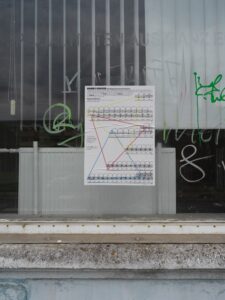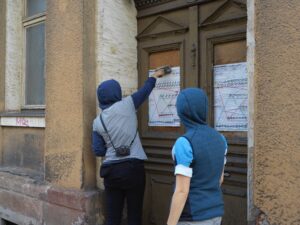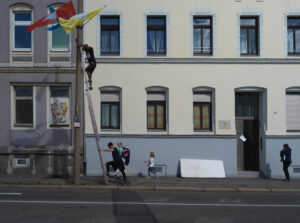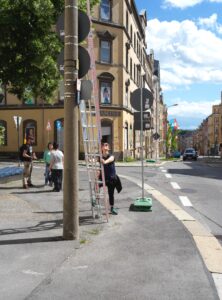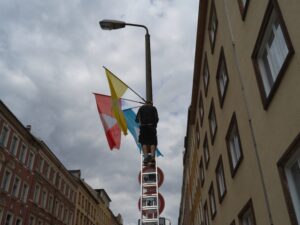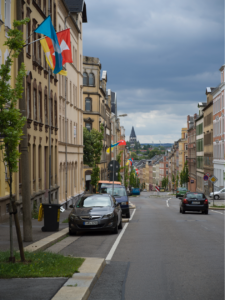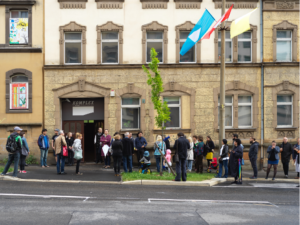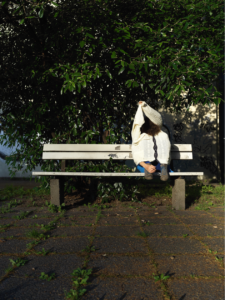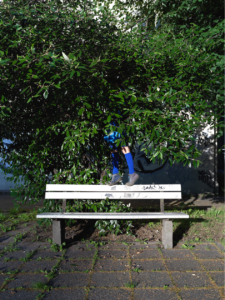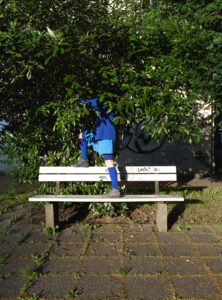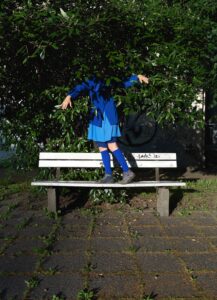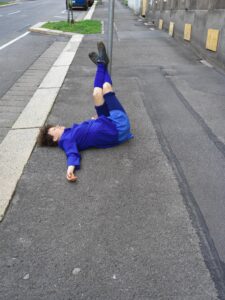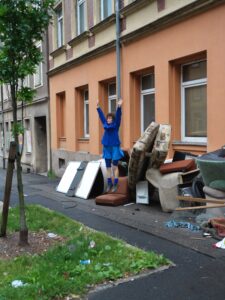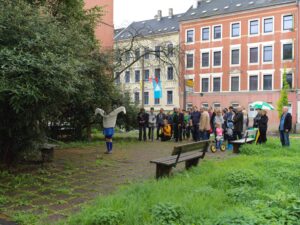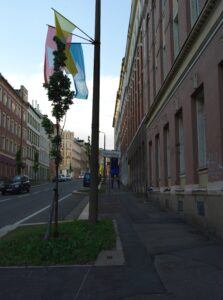In 2017 standen die Dialogfelder noch nicht unter einem thematischen Rahmen. Das Hauptaugenmerk lag darin, einen Austausch zwischen bildender und performativer Kunst im öffentlichen Raum zu schaffen. Daher luden wir jeweils eine/n Künstler*in aus beiden Bereichen ein, gleichzeitig Vorort Projekte zu entwickeln, welche im besten Falle in einen Dialog traten.
Dialogfeld 2
-
ANNA SCHIMKAT
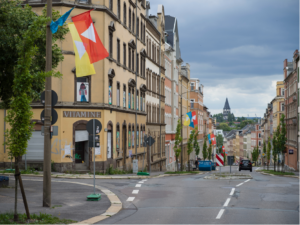
Reception, perception and apperception. These are the three stages of perception as described by Gottfried Wilhelm Leibniz in his Monadology in the 17th century. An inner principle, which he describes with the term “appetite”, enables the change or transition from one perception to the next. Apperception is the stage of perception that treats sensory experience attentively, raises it to consciousness and places it in a context from which the decision to act can follow.
Hearing is a sensory experience that we humans can hardly escape. We can close our eyes and actively cover our ears. Hearing is inextricably linked to a sense of the situation, to experiencing, feeling and (self-)perceiving the body and its surroundings as well as the exchange between people. The perception of space is therefore always linked to the sense of hearing. But when does the perception of what we hear emerge from the subliminal noise and become a conscious process? When does the perception of space become a perception of the person himself?
Coming from sculpture, my understanding of art is a space-creating one. In my installations and objects, I question the existing space, develop new spaces of perception and concentrate on the sound (within it). The found sound of things and surroundings is my inspiration and basis. It is my material, from which I playfully research and follow the respective concept, the sounding, whirring, noise,
clattering, clicking, plugging, crashing, humming - filtering out the specific sound, the specific form. My own acoustic experience serves me as a sounding board for an open production of knowledge. For example, I collect wind noises and compose them over the years, make a train station resound or put the neuroscientific measurement of perception up for discussion by condensing the noise of a functional magnetic resonance tomograph used in brain research into a space-time composition. -
Vorwärts vergessen
-
ANNA SCHIMKAT

Reception, perception and apperception. These are the three stages of perception as described by Gottfried Wilhelm Leibniz in his Monadology in the 17th century. An inner principle, which he describes with the term “appetite”, enables the change or transition from one perception to the next. Apperception is the stage of perception that treats sensory experience attentively, raises it to consciousness and places it in a context from which the decision to act can follow.
Hearing is a sensory experience that we humans can hardly escape. We can close our eyes and actively cover our ears. Hearing is inextricably linked to a sense of the situation, to experiencing, feeling and (self-)perceiving the body and its surroundings as well as the exchange between people. The perception of space is therefore always linked to the sense of hearing. But when does the perception of what we hear emerge from the subliminal noise and become a conscious process? When does the perception of space become a perception of the person himself?
Coming from sculpture, my understanding of art is a space-creating one. In my installations and objects, I question the existing space, develop new spaces of perception and concentrate on the sound (within it). The found sound of things and surroundings is my inspiration and basis. It is my material, from which I playfully research and follow the respective concept, the sounding, whirring, noise,
clattering, clicking, plugging, crashing, humming - filtering out the specific sound, the specific form. My own acoustic experience serves me as a sounding board for an open production of knowledge. For example, I collect wind noises and compose them over the years, make a train station resound or put the neuroscientific measurement of perception up for discussion by condensing the noise of a functional magnetic resonance tomograph used in brain research into a space-time composition. -
Vorwärts vergessen
-
DANIELA LEHMANN
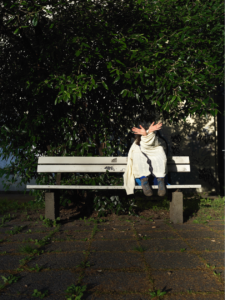
Daniela Lehmann likes to go off the beaten track in her performances. With her movement compositions, she likes to explore places in urban spaces that are far removed from dance. Her movement language is inspired by these landscapes, their textures and the people performing there. A central method of her work processes is value-free observation, which enables her to integrate peculiar gestures into abstract dance with ease. In this way, she creates personages that dare to be perceived as weird and crazy by the viewer, for example “Mina” - a solo piece with which she won first prize and the audience award for “Best German Dance Solo” at the euroscene festival.
Daniela Lehmann is a trained dancer and choreographer and also studied sociology and philosophy. She is a member of Zentralwerk e.V. and active in TanzNetzDresden, where she constantly questions established structures and combines them in new ways with curiosity. This is also reflected in the process of her productions, in which visual artists, craftspeople and other professions come together alongside performing artists. She is currently working with a watchmaker, an electric guitarist and a cellist on the piece NEBEN DER SPUR, in which the stage landscape consists of a car wreck and 100 car tires. It premieres on September 1, 2017 at the Zentralwerk in Dresden.
-
-
DANIELA LEHMANN

Daniela Lehmann likes to go off the beaten track in her performances. With her movement compositions, she likes to explore places in urban spaces that are far removed from dance. Her movement language is inspired by these landscapes, their textures and the people performing there. A central method of her work processes is value-free observation, which enables her to integrate peculiar gestures into abstract dance with ease. In this way, she creates personages that dare to be perceived as weird and crazy by the viewer, for example “Mina” - a solo piece with which she won first prize and the audience award for “Best German Dance Solo” at the euroscene festival.
Daniela Lehmann is a trained dancer and choreographer and also studied sociology and philosophy. She is a member of Zentralwerk e.V. and active in TanzNetzDresden, where she constantly questions established structures and combines them in new ways with curiosity. This is also reflected in the process of her productions, in which visual artists, craftspeople and other professions come together alongside performing artists. She is currently working with a watchmaker, an electric guitarist and a cellist on the piece NEBEN DER SPUR, in which the stage landscape consists of a car wreck and 100 car tires. It premieres on September 1, 2017 at the Zentralwerk in Dresden.
-

